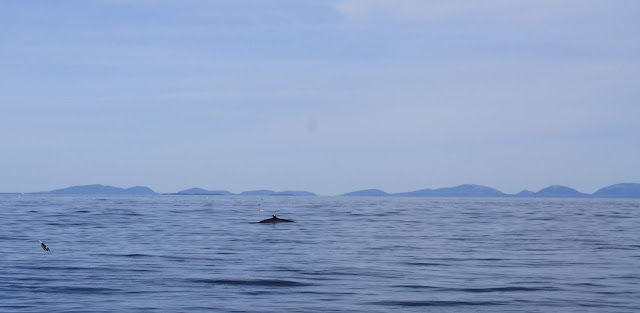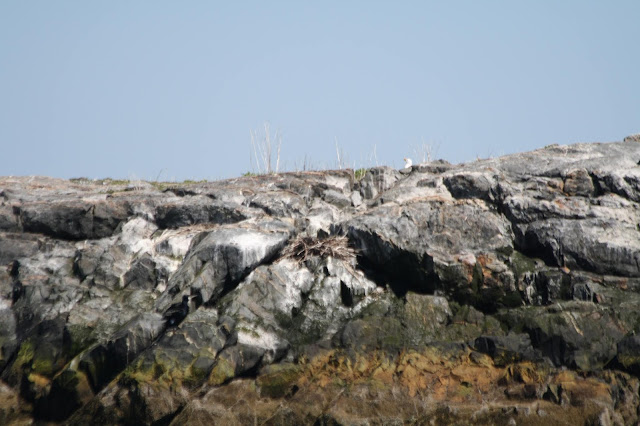This article is from the National Audubon Society
Puffin project website.
(My comments are inserted in the body of the
article)
Common Murres Nest at Matinicus Rock!
Discovery
Result of (really?)
Audubon’s 17-year Effort to Restore the Penguin-like
Seabird to Maine Coastal Islands
For the
first time in more than a century, a Common Murre (Uria aalge) egg
has been discovered south of the Canadian border, boosting hope for the success
of valiant (?) efforts to restore
the species. The rare egg was discovered by an intern working for Audubon’s
Seabird Restoration program on Matinicus Rock, one of 50 islands in Maine
Coastal Islands National Wildlife Refuge.
"We are
absolutely elated. This is a small egg, but with a big promise," said Dr. Stephen Kress, director of the Seabird Restoration
Program."We have high hopes for the successful hatching and fledging of
this egg, and for greater numbers of murres in years to come."
The egg
marks the first time since 1883 that the species, which spends most of its life
at sea, has nested south of the Canadian border on the U.S. east coast.
(This
would have been a good time to describe the regional murre population and its
recent history you could say something like “the first 20th century record of this species breeding
in the Gulf of Maine was in 1973, the population has been growing from about 50
pairs in 1981 to in the order of 1500 individuals by 2012, who breed on crowded
ledges about 100 miles east of Matinicus Rock at Machias Seal and Yellow Murre
ledge”.
The
rhetoric used appears to be deliberately misleading apparently chosen to
maximize the appearance of accomplishment rather than to educate.)
It was
discovered on a rocky cliff by intern Maria Cunha, after she noticed a pair of
murres in typical incubating posture. The nest was surrounded by about 50 murre
decoys, and artificial eggs, and close to a sound system that emits murre calls
to encourage the long-absent birds to establish new nests. (As if the urge to
breed was somehow latent in this population, also Murre don’t have nests)
While
widespread on the Pacific coast from Alaska to California, and breeders in
Canada’s Maritime Provinces,
Common
Murres were eliminated from their Maine breeding sites in the 1800s by people
hunting the birds for food. Collecting of eggs—a popular pursuit at the
time—may also have contributed to the disappearance.
(another
good chance to mention the swelling murre population in the Gulf of Maine)
Common
Murres are especially vulnerable to oil spills and predation, so new colonies
within their historic range offer the best assurance for their survival. (Is there any
threat to the survival of this species? you could just say something like.. Its
nice to have them in the region again) Audubon and
partners from the Maine Coastal Islands National Wildlife Refuge have spent 17
years trying to bring the Common Murres back to the islands. (after a decade
of which murre chose to established breeding on Machias Seal island instead (100
miles East of Matinicus Rock 2.5 hours by Murre), where there was no “murre
attraction effort”. What was that
the result of? Discussion on the subject absent this reality is not a serious
evaluation of the use of social attraction in this case.
Skeptics might be inclined to see the
murres choice of Machias Seal as pretty good evidence that the social
attraction effort was irrelevant. There is also a growing population of well over
a thousand Razorbills, a very similar species, who attend Matinicus rock, ~400
breeding pairs.
Which has been more important for
attracting murre to this site, hundreds of very similar birds commuting many
miles between feeding grounds and the Island or a bunch of plastic decoys that
you have to be within 100m of to see?)
Regardless
of the fate of this specific egg, its presence signals a success story in the
making. (clearly the author ? knew the egg was consumed by a
predator. The murre distraction
equipment was set up on a site chosen by people, it was out in the open, the
successful murres on Machias Seal have laid their eggs under boulders where
they have shelter from gulls. By distracting the murre to this human chosen open
vulnerable place, away from where their instincts, geography and their little
feet would have taken them, it seems as likely that the “murre attraction
effort” delayed the successful re-colonization of this site as it is that it
accelerated the process.)
"Each
new colony offers another margin of safety for Common Murres and other
seabirds," said Kress. "The return
of the Common Murre to its long-lost nesting grounds shows that conservation
works – even against great odds."
(Against great odds? The continued
expansion of this species was predictable considering the swelling population
at crowded colonies on small islands not far to the east. In this sense
conservation means only not rowing out to yellow murre ledge and collecting all
the murre eggs every year)
Common Murres are not the first seabird species that Kress
and his team (this article is on the puffin project website, written by Kress
or “his team”) have helped restore to Maine. (never miss a chance
to reinforce the myth that there were no Puffin in the Gulf of Maine in
1975, (there were 1,000 pairs, capable of producing in
the order of 10,000 new Puffins during the 15 years during which the NAS
valiantly added about 70, At the cost of over 1,600 others.)
Pioneering
the use of decoys (this is an
appropriate time to acknowledge that Richard Pough and colleagues used decoys
when trying to re-establish terns to Great Gull Island in Long Island Sound
during the late 1940s)
and sounds now employed to attract the Murres,
The team began working to attract Atlantic Puffins to the
Maine coastal islands in 1973; four breeding pairs nested at Eastern Egg Rock
in 1981, after an absence of nearly a century. Today, Project Puffin protects
more than 42,000 of Maine’s rarest
seabirds on thirteen islands. (“rarest”
implies some scale of rareness to help establish conservation priorities, the
track record indicates otherwise, and if there are 42,000 of them what is so
rare about that)
Their
techniques (Eliminating predatory gulls from nesting sites) have also helped establish 12 new tern colonies in Maine and
are proving useful for helping endangered seabirds in California, the Galapagos
Islands of Ecuador, and Japan. At least 40 seabird species in 12 countries have
benefited from seabird restoration techniques developed by Audubon.
Credibility is perishable and given the degree to which National
Audubon has misrepresented the import of their work here in the Gulf of Maine I
am inclined to be very skeptical of stories of the alleged success of the use
of social attraction at seabird islands elsewhere in the world where I have no
idea what’s going on.
An organization that is doing important seabird conservation
work is ”Conservacion del las islas”, a Mexican organization with a staff of 50
and seasonally employs twice that.
This group has worked for years to clear seabird islands of destructive
vermin primarily rats, cats, goats and pigs. They have done this on very large
islands in the Caribbean the Gulf of California and the Pacific. That is the important hard work needed
to enable the reestablishment of seabird colonies.
Social attraction works when? When that is probably what was
going to happen anyway. When there
is a site from which predators/vermin have been eliminated or never existed,
where habitat is suitable or has been made so and most importantly there needs
to be a population of birds looking for a place to nest. Which occurs during times of growing
population or when a former breeding site has been disturbed. In the first case managers don't need to do
anything and in the second case better the managers priorities be to look into
disturbance at the source site.













































































